.png)
Demand generation vs lead generation. What used to be a game of demo form conversions and gated content downloads is quickly becoming one of generating interest and providing friction-free value. Read on to discover why this philosophical shift is happening, and how you can implement winning demand gen tactics at your business.
Meet Josh.
Josh works as a senior marketing manager at a mid-sized B2B firm based out of New York City. Lately, he’s been curious about Conversion Rate Optimization (CRO). He ran a quick Google search and came across a seemingly comprehensive blog post by a CRO company.
The blog turned out to be quite informative and piqued his interest further. A week later, he came across a LinkedIn post for a webinar the same company was hosting that promised insights from some of the leading industry experts. Naturally, he was excited to learn more, so he signed up for the webinar.
Fast forward to a few days later - he stumbled upon an ad by the company promoting one of their customer’s success stories. Upon giving it a quick read, Josh was impressed with how relevant their solutions were and how well they were aligned to his team’s pain-points. And that was it; Josh decided to take the plunge to sign up for a free trial, wanting to try out the platform for his team’s marketing needs.
That is a classic example of how demand generation (or demand gen, for the cool kids in the back) works. Demand generation is the end-to-end process of building interest, awareness, and intent via multiple touchpoints and marketing programs over a period of time, with the intention of educating the targeted audience in an effort to create demand for a business.
Compare the above situation to one where Josh discovers a gated, downloadable guide titled “Improve your site conversion by 30% in 30 days”. He’s immediately interested to give it a read and is willing to share his contact information to get a copy of the guide. That’s a typical example of how lead generation (or lead gen) works, and differs from demand gen. Unlike demand gen, Lead generation focuses on capturing leads (or contact information of prospects) via marketing efforts with the intention of generating a pipeline of prospects who can be further persuaded to convert into a customer.
That said, demand gen and lead gen are not very independent of one another. In fact, lead gen is a subset of demand gen. In a marketing funnel view, demand gen is at the top, responsible for creating interest in the brand. Meanwhile, lead gen is at the very bottom of the funnel , responsible for converting prospects into leads.

What is lead generation?
A bottom-of-the-funnel tactic, unlike demand gen, lead generation is the second to last step in the buyer’s journey that gets potential customers to share their purchase intent in response to a well-planned and compelling marketing effort (more on those in a bit). Lead gen encompasses all marketing tactics that request contact information in exchange for a value add.
From door-to-door sales and cold calling to targeted ads and emails, the process of discovering, engaging, and converting leads has evolved tremendously over the past few decades. What remains unchanged is the fact that marketing is incomplete without persuading prospects to express their intent towards purchasing a product or service. And that’s where lead generation comes into the picture.
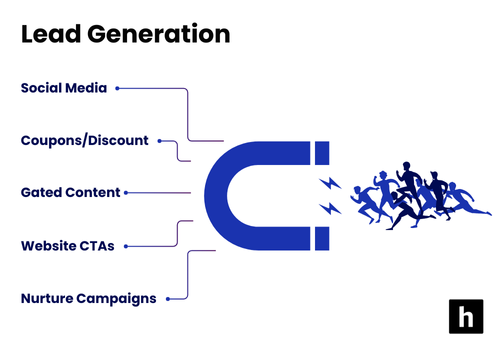
To get a better sense of what lead generation vs demand generation entails, let’s go over the most prevalent classifications of “leads”.
Marketing qualified leads (MQLs): Potential customers who have expressed interest in a business in response to a marketing activity. An MQL for HubSpot, the marketing automation platform, would be a marketer who has signed their business up for a free trial of the platform and wants to explore its features.
Sales qualified leads (SQLs): Prospects who have higher intent than MQLs as they have moved into the sales pipeline and been qualified by the sales team (after being nurtured by marketing). An SQL for the CRM software, Salesforce, would be a business that has signed up for a free trial and also had a meeting with the account manager on how the tool can be used for their particular use case.
Product qualified leads (PQLs): Prospects who have expressed intent in purchasing a product or service after having experienced it first hand via a free trial or freemium version. A PQL for Canva, the graphic design platform, would be anyone who creates and exports a design using their freemium service.
Since inbound marketing has replaced outbound almost completely, 61% of marketers admittedly find not demand gen, but lead generation one of their biggest challenges. If this number is anything to go by, lead gen has only become more competitive and demanding in the past few years. However, some robust strategies have continued to prove their worth in driving visitors to convert.
Let’s take a look at some of those (that might also serve for demand gen) below:
Lead generation 101: Gating high quality content
While not the best strategy to boost the readership, offering gated content works well in getting visitors to submit contact information in exchange for a value-packed report, eBook, or whitepaper. To make the most of your efforts, include a quick snippet of the actual content in the landing page to offer a sneak peek into what the asset promises.
Here’s an excellent example:
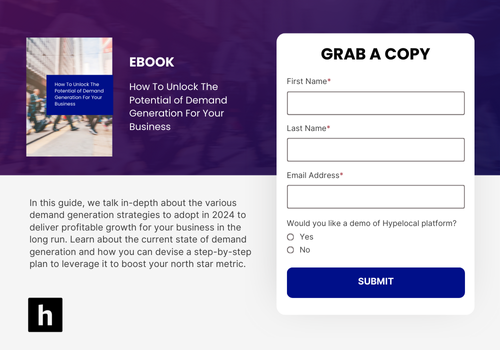
Creating lead magnets for your digital properties
Your lead gen efforts are incomplete without creating action-driven lead magnets. Lead magnets are valuable resources created solely with the purpose of collecting leads. These are highly targeted and contextualized, and help collect information from niche website visitors who are likely to be interested in a particular topic.
For example, if a visitor spends time reading an article about A/B testing on your blog, you could offer them a free (but gated) tool that they can use to generate their first test hypothesis. This way, you end up personalizing content for your target audience, which is harder for them to pass-up.
Let’s take a look at an example of an effective lead magnet:

Using FB lead gen ads and Twitter lead gen cards to convert on social
Probably the most efficient way to collect information from mobile users without interrupting their social media browsing experience is through paid social media channels. Facebook and Twitter both offer tools to help businesses generate leads via ads, wherein pre-populated forms do the grunt work.
Facebook lead ads allow you to run ads with lead information already filled in, and if a user is interested in submitting it, they just need to give their consent by tapping a button. This way, you are ensured minimal drop-offs as your prospects don’t need to hop between browser tabs or apps to fill in forms. Twitter lead gen cards offer a similar service to collect leads via Twitter ads without making users leave the app or type in any information.
Here’s a snippet of how you can make lead gen work on social media:

Optimizing website CTAs for effective lead generation
Your website is your digital salesperson, and a CTA on your site is the digital equivalent of a salesperson guiding a potential customer through checkout. The placement, copy, color, font, and literally every aspect of your CTA button impacts its conversion metrics, as it consciously or subconsciously affects buyers’ decision-making. Therefore, CTAs should be one of the primary elements you constantly A/B test to ensure optimal website conversions for your lead gen efforts to work.
Here’s an example:
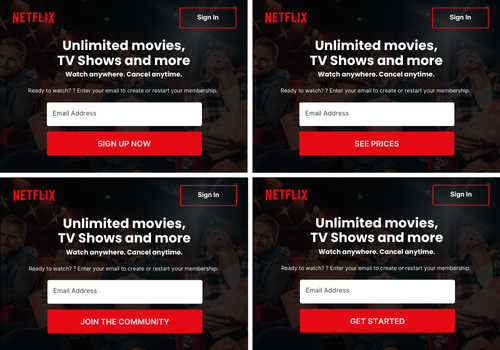
Using nurture campaigns for pipeline acceleration
Your lead gen results are only partially achieved if you simply capture prospects’ contact information and don’t make any effort to regularly engage with them and close faster. You run the risk of those leads losing interest and your efforts going to waste.
Instead, create a dedicated roadmap to target such prospects via personalized emails to educate them further about your offerings and how they can benefit from it. You could use your best performing content resources, webinar and podcast recordings, or other sales enablement assets to close the sale faster.
What is demand generation?
Demand generation (or demand gen) broadly entails identifying and steadily influencing buyer behavior using a number of marketing strategies across several user interactions and multiple channels to get prospects to explore value in your product or offering and convert on their own means, rather than through a pushy form-fill.
Ask ten marketing teams what their definition of demand generation is, and you’ll end up with at least seven different definitions for demand generation. For one thing, demand generation has no specific definition and every marketing team has their own interpretation of it that fits their business’ context. And also, the concept alone can be quite nuanced that summing it up might not do justice to it.
While leads are an inevitable and necessary outcome of demand generation, they’re definitely not the only objective, and that’s how this strategy differs from the classic, much more tactical, lead generation approach. The primary objective of demand generation is to createorganic and long-term brand growthwhile also building, maintaining, and growing a healthy pipeline consisting ofhigh-intent prospects over time.

Creating a thoroughly-defined target persona is the first step towards building a sustainable and effective demand gen strategy that spans across campaigns, user journeys, touch points, engagement channels, content assets, and weeks or months. A winning demand gen strategy is focused at meaningfully engaging the target audience throughout their user journeys, whether or not you may immediately be able to fill your sales pipeline.
Let’s look at a few evergreen demand generation activities:
Demand generation 101: Creating a comprehensive content marketing strategy
In his decade-old, but still relevant TED Talk, Simon Sinek talks about how some businesses and some leaders are able to inspire action while others fall into the trap of executing campaign after campaign, only for their audience to ultimately tune them out for good.
He talks about why marketing should always begin by answering the question “why”, rather than “what”. So, instead of focusing excessively on what it is that you’re selling, think about the purpose, cause, belief, and vision behind why you’re doing it and start backwards from there. Why do you believe in your vision? Why is it relevant or important to your target group? And why should they listen to you?
Demand gen is all about answering that “why” and making sure it reaches your audience and a well-rounded content marketing strategy can help you do that as effectively as possible. Aim to create content to inspire rather than persuade, enlighten rather than sell, and drive meaningful brand engagement rather than instant results.
Once you are done determining your “why”, you’re only a few steps away from leveraging content fruitfully for your demand gen strategy:
- Conduct in-depth keyword research to create a list of high-intent search queries and phrases
- Make sure your content is optimized for these keywords, while being highly educational and inspiring
- Use your content to generate organic growth via social posts, podcasts, webinars, backlinks, and more
- Constantly gather and assess audience feedback and optimize your content accordingly to ensure your demand gen efforts are going in the right direction
HubSpot is an extraordinary example of how content alone can drive limitless success for a business primarily through the use of inbound. From its early days, HubSpot has always focused on creating high-quality, educational content for a particular section of their audience - those who were interested in learning. HubSpot ushered in the era of inbound, wherein content was leveraged to generate interest, awareness, and ultimately demand for a particular product. Their content has always been a goldmine of insights and they’ve constantly stayed away from aggressive sales plugs.
Exploring partner marketing and teaming up with industry experts
For your demand gen efforts to work, you need to ensure that you are being heard by your target prospects. An effective way to reach your target audience is by partnering up with experts who have already created a strong following in the particular community. Partner marketing is slowly gaining traction as it allows businesses or thought leaders to come up with a mutually beneficial arrangement wherein both parties gain from each others’ expertise and marketing efforts.
You too can look for businesses in your industry that you could team up with and create shared content resources, organize a collective event, build a cross-promotion plan, and so much more.
Start by creating a list of businesses that are trying to reach the same target audience as yours and reach out to them asking if they are interested in collaborating. You want to preferably go for businesses with a higher domain authority, social following, and market share than yours to ensure you receive the desired results from the partnership. While doing so, also prepare a list of topics for the content resource/webinar/podcast that you are proposing so the other party sees value in your exploring the same.
Conducting webinars and podcasts to boost engagement
A quick Google search will give you tons of statistics on how webinars and podcasts are the next big thing in engagement and demand gen. With ever-decreasing attention spans, your target audience needs options when it comes to consumable content formats that won’t require too much patience and still offer a goldmine of insights.
To get started,
- Create a calendar for webinars and podcasts that you plan on launching in the upcoming quarter
- Come up with a comprehensive list of prospective topics and guest speakers
- Try to cover a combination of broad topics and niche ones to attract optimal footfall and generate awareness in your category, while also providing thought-leading insights
Take a look at Drift nailing the webinar game for demand gen:
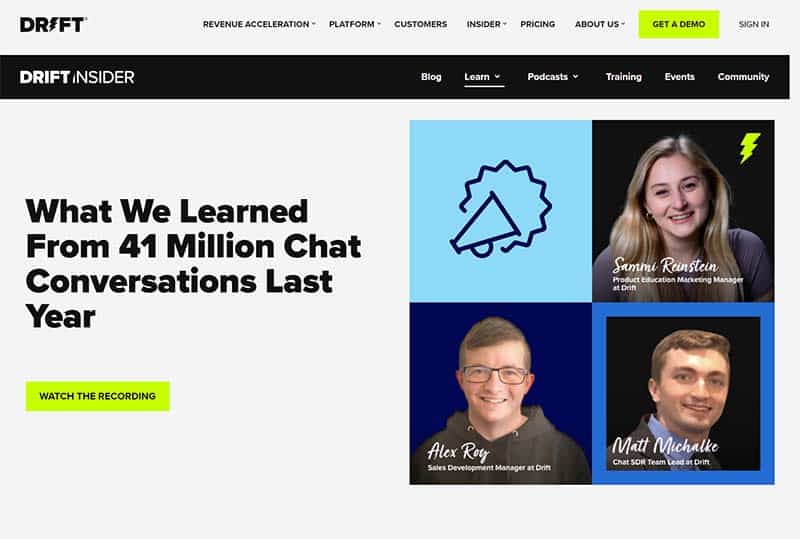
Doubling down to showcase success stories
Your demand gen efforts are incomplete if your audience is not aware of the kind of results you can promise them. Success stories give your target audience an idea of the great results your products or services have delivered for other businesses in the same category, and what better way to generate interest in your business than by sharing your best work with the world. The best part about success stories is that you can always repurpose them to act as sales enablement assets, client pitch decks, shoutout posts for customers, paid advertisements, and more.
To get started,
- Reach out to your customer experience team to determine success story candidates
- Contact desired clients to gauge their interest
- Conduct a thorough interview to gather insights for the story
- Get the client’s approval on your draft
- Finally, publish your success story and promote it
Here’s a great success story by Stripe that serves their demand generation efforts:

Offering free trials of your products or services
Demand gen for your business in the long run is also a function of the quality of experiences people have with your product and/or services. You don’t want to limit those experiences to just paying customers, but also extend them to potential ones.
Offering free trials or freemium versions of your product will encourage prospects to try it out, and there are only two possible outcomes from there (none of which are bad). You either win over a customer or get loads of feedback to make your product better! As part of its demand gen strategy, Shopify offers a 14-day free trial.
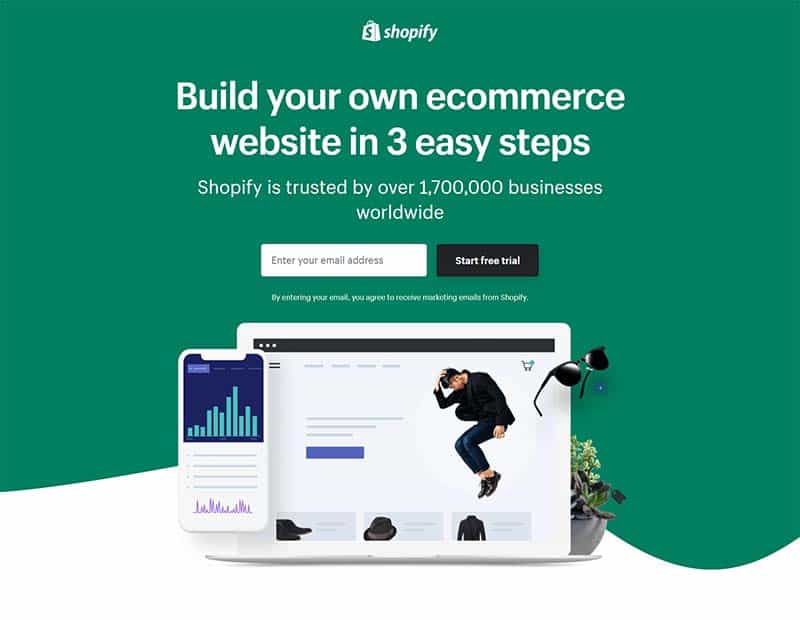
Demand generation vs lead generation
Now that we’ve gone over the nitty gritty of the two marketing philosophies, it’s crucial to understand how they’re different. Here’s a quick exploration of what we’ve discussed so far for demand gen vs lead gen.
Lead Generation (Lead gen)
Demand Generation (Demand gen)
Stage of Funnel
Bottom of the funnel
Full funnel
Focus
Short-term goal (ex - monthly MQL target)
Long-term business growth
Audience Intent
Low
High
Desired Outcome
Conversion
Brand awareness
Examples
A successful form fill or sign up for a demo or free trial.
Better social engagement, improved time spent on-page, higher footfall for webinars & podcasts, etc.
You will often find marketing teams confusing demand gen and lead gen, using them interchangeably or paying little heed to how largely dissimilar the two are. However, if you plan on maximizing your marketing ROI, it’s imperative to internalize the above chart to effectively decide where your focus should lie (spoiler alert: it’s demand gen).
Demand generation: The key to long-term business growth
Demand gen vs lead gen is really a debate about your vision and mindset as a marketing team. If you are seeking the easy way out, you can execute a bunch of lead gen campaigns a month, collect low-intent leads, pass them on to your sales team, meet your targets, and call it a day! However, if you are in it for the long haul and want to achieve long-term business sustainability, demand gen is the only way to go about it.
Instead of focusing on getting quick conversions by persuading visitors to sign up or fill a few forms, take a more strategic approach towards educating your buyers and offering value. Work towards defining buyer behavior via your content and messaging, bringing and encouraging change, helping the overall ecosystem evolve, and in turn generating demand for your business.
Internalizing demand gen philosophy will ensure that your overall lead quality in the long run improves by leaps and bounds. Focusing on lead gen month after month will only attract poor quality, low intent leads that won’t really contribute towards your bottomline in the long run.
Your audience will appreciate your efforts in providing quality content that helps them solve a business or personal problem as opposed to repeatedly following up for contact information. The few leads you collect via demand gen activities will be worth more in business dollars than the thousands you do via forced form-fills as part of your lead gen efforts. The reason is simple - if your leads aren’t high-intent or they haven’t entered the funnel organically after thorough research, they’ll drop off very early in the sales process.
In this world of instant gratification, creating a well-rounded demand generation marketing strategy that requires patience, resilience, and constant efforts can be harder than it sounds, but it will all be worth it in the long-run. Your lead quality will improve, you won’t have to work as hard to persuade prospects, and awareness about your business category and product will grow organically.
Focus on lead gen, and you’ll meet your monthly/quarterly MQL targets; focus on demand gen and you’ll always have a steady, healthy, and promising pipeline to look forward to.
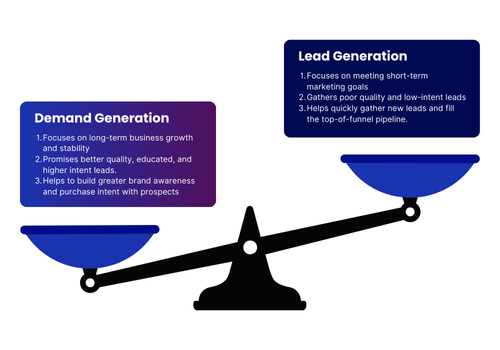
Gaining a thorough understanding of demand generation is merely half the job done. To get the desired results from your efforts and deliver profitable growth for your business, you need a robust plan that you can immediately set in motion and rely on.
At Hypelocal, we’re on a mission to help you unlock the full potential of demand generation for your business and make the journey effortless for you. From SEO and SEM to conversion rate optimization and content marketing, Hypelocal is a result-oriented digital marketing agency that is here to do the heavy-lifting when it comes to demand gen, so you can focus on accelerating your business’ growth.
To get a better understanding of how Hypelocal can build sustainable demand gen strategies to meet your marketing goals and vision, request your free digital strategy session with us. Insert Table of Contents
You may also like

How To Use Storytelling In Marketing
Make your customer the hero—use the Hero’s Journey to craft stories that inspire action and build stronger brand connections.
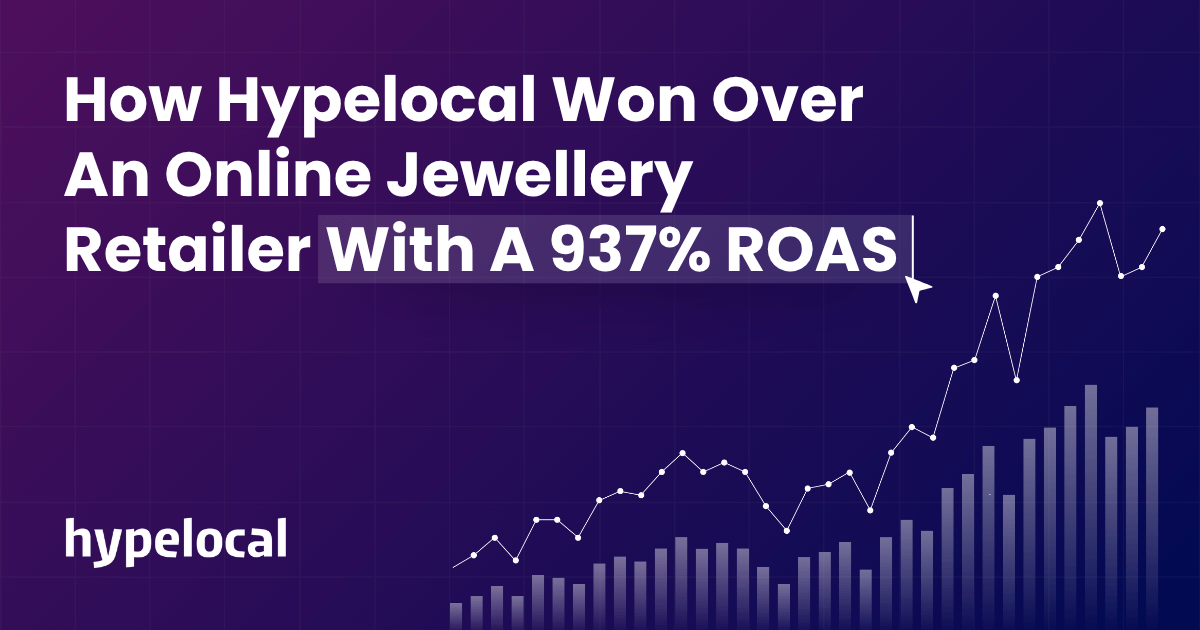
How Hypelocal Won Over An Online Jewellery Retailer With A 937% ROAS
Hypelocal’s ad strategy provided this jewellery retailer with $420K revenue and 937% ROAS.



